- Home
- Knox Family
- Knox Family Relatives
- ME 846 History
- E-Books
- Contact
| A BRIEF
HISTORY OF SCRUTON© C. S. PRESTON-APRIL 1985 There has been a settlement at Scruton certainly since the Angles came here in the 6th or 7th Century A.D., they perhaps advanced up the old Roman road which we now call the Al. We do not know the name of that settlement because, in the 9th Century, the name of a Viking, Scurfa was substituted in the Anglian place-name, whilst the final part of the place-name (“tun”) was retained. The name thus became Scurfa’s tun (Scurfa’s Farm); by the time of Domesday (1086 A.D.) it was Skurveton or Scurueton, and later Scruton or Screwton. Just before the Norman Conquest there were two “manors” or farms here belonging to Cnut and Torfin, as well as land owned by Gernan, but after the Conquest the lands in Skurveton were allotted to Picot de Lascelles, a vassal of Count Alan the Red of Brittany. Count Alan was a friend of the Norman Queen, and was granted many manors round the town of Richmond , where he built his castle. |
 |
| This new extended manor of Skurveton
remained in the hands of the Lascelles family until the end of the
13th Century. It subsequently passed to the Markenfields of Markenfield
Hall in 1314 and to the Danbys of Thorp Perrow at the end of the
16th Century.
The oldest surviving building in Scruton is the Church, which was built as a lofty barn-like structure in the 12th Century. The aisles and chancel were added in the 13th Century and the tower in the 15th, but much of the old building disappeared in an over-enthusiastic Victorian restoration by the Squire, Henry Coore, in 1865. Those with a taste for Church architecture may like to amuse themselves in finding the remains of the original 12th Century building, and dating the other parts. The church still bears its original dedication to St. Radegund, the Queen of the Merovingian King Chlotar I; she died on August 13th, 587 A.D. and was buried at Poitiers in France . It is one of only five churches in England , all mediaeval, with this dedication. Scruton saw fighting during the raids by the Scots in the first half of the 14th Century, when much of Yorkshire was devastated. It is said that at this time a battle with the Scots took place on Scruton Moor, the area to the west of the village (where Moor House Farm is today). Richmondshire was also a centre of activity during the “Rising of the North” of 1569, in support of the old Catholic religion. The “Provost Marshall in the Northe partes”, charged with opposing the rebellion, was Sir George Bowes. The constables reported to him that 12 men had joined the rebellion from Scruton, and two of these were appointed to be executed, but it appears that only one was caught and put to death. Thomas Markenfield of Markenfield Hall, who then owned the manor of Scruton, was involved in the Rising and he also was executed; his lands were confiscated and in 1571 the Crown granted Scruton to Sir George Bowes no doubt as a reward for his services. For the whole of the mediaeval period the manor of
Scruton was an agricultural community under the control of a manorial
court, meeting at the Manor House. You can still see in some of
the Scruton pastures the ridge and furrow which remains from the
mediaeval strip fields. The manorial water mill was at Grimescar; Mill Lane is still there but little else. The mill and the nearby Grimescar farmhouse stood on the edge of Leeming Aerodrome, and shortly before midnight on 13th March, 1942 , a Whitley of 77 Squadron coming in to land after an operational flight hit and damaged the farmhouse, crashed and caught fire, killing the members of the crew. All the buildings at Grimescar were later demolished. The mediaeval common fields were enclosed by the middle of the 17th Century, and the Manor House was rebuilt about the same time in the form in which it still stands today. One of the landowners in Scruton was Dr. Thomas Gale, a member of an old Scruton family who later, in 1688, purchased the manor of Scruton and became the Squire. Dr. Gale was a clergyman and one of the most learned men of his time. He married a second cousin of Samuel Pepys the diarist; for much of his life he was headmaster of St. Paul’s School in London, and subsequently was a successful Dean of York. He was buried in York Minster where you may see his memorial stone. His eldest son Roger was also a nationally-known antiquarian; he was M.P. for Northallerton from 1706 to 1713, and Scruton’s first historian. He was buried in Scruton Churchyard, but he left instructions that there was to be no stone to mark the place. It was Roger Gale who about 1705 built Scruton House, later known as Scruton Hall, which used to stand behind the high wall to the west of the Church. It started life as a simple but attractive Queen Anne house, but wings were added later, which made it a much grander building. All the Scrutonians who knew the Hall greatly regret its needless destruction in 1956. Between 1718 and 1720 Roger Gale planted the old Lebanon cedars which still survive in Scruton Park. There was a threat of further strife in Scruton in 1745, when Bonny Prince Charlie marched south from Scotland. Local defence associations were formed all over Yorkshire, and our Squire, Roger Henry Gale, a ne’er-do-well son of the famous Roger, fled rather precipitately with his family to Stamford. In fact he was probably in more danger at Stamford than he would have been at Scruton, for the Pretender came down the west coast route and never touched Yorkshire. He found that his expected Catholic support never materialised and he retreated in disarray. Poor Roger Henry ran into trouble of another sort on his way back to Scruton. Due to floods and bad roads, the 125 mile journey lasted 5 days! Alfred Coore's GravesiteIn 1795 the direct male line of the Gales died out, and eventually the manor of Scruton passed through marriage to the Coore family. One of the more remarkable members of that family was the Rev. Alfred Coore, who in his later years was Rector of Scruton from 1936 to 1943. In 1898 when a young man, he had gone out to India as a missionary. Although self-taught and not qualified as an architect, he started to design and build churches with great success in a blend of hindu and Mogul styles. he designed about 50 churches, schools and other buildings. he died in 1947, and the Scruton estate was finally sold off in 1953 after his brother Alban died, but the name still survives in Scruton in the Coore Arms, the Coore Memorial Hall and Alban Coore Place. The Coore Memorial Hall was in fact the old National
School, opened in 1860, where several generations of Scrutonians
received their education. Despite opposition in the village, it
was closed in 1967 and Scruton children are now bused to Morton
and Northallerton. The old Rectory facing the village green was built in 1742 and it replaced at least one, and possibly more, earlier parsonages, for the names of Scruton Rectors can be traced back to the 13th Century. With the grouping of parishes which is now a feature of the Anglican Church, the Rector of Scruton is also Vicar of Ainderby Steeple with Yafforth. He lives at Ainderby Vicarage, so we no longer have a resident parson. The Methodist Chapel in Station Road was converted from a house in 1879 at a total cost of £300.00 but there is a record of a house in the village being used as a chapel in 1840. The old Scruton Lane Railway Station still survives – but only just! The Wensleydale line from Northallerton reached Scruton in 1848 and freed the township from its dependence upon horse-drawn vehicles. Although schedule passenger services ceased in 1954, the line is still used for quarry freight traffic and the odd holiday excursion; and on at least two occasions the Royal Train carrying our present Queen has passed up the line en route to a quiet siding for an overnight stop. These are the only royal visits to Scruton that I know of, if we can discount the tradition that Mary Queen of Scots once slept at the Manor House! Before the days of the railway, Scruton was of course a much more self-contained community than it is today. The Census tells us that in 1841 there were about a dozen people of independent means, 15 farmers with farms ranging from 20 to 300 acres, about a dozen adult children of farmers working on the farm and 40 agricultural labourers of both sexes and all ages. There were 43 general servants in the village, fairly evenly divided between men and women, a very varied assortment of tradesmen and craftsmen also lived and worked in Scruton: carpenters, joiners, bricklayers, shoemakers, blacksmiths, cartwrights, upholsterers, nurserymen, gardeners, weavers, tailors, butchers, a draper and a miller. There were deficiencies: no doctors or dentists, even though the parson was usually prepared to pull a tooth if you were desperate! And mains water did not reach Scruton until 1939. The more recent arrivals in the village can now enjoy its pleasures without having to endure the former inconveniences! April 1985© C. S. Preston Scruton |
|
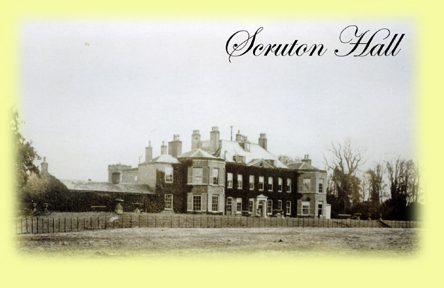 |
|||
 |
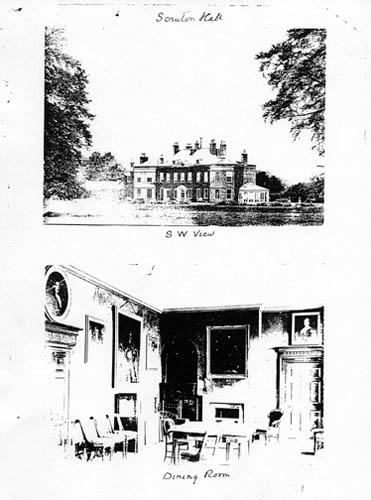 |
||
 |
 |
||
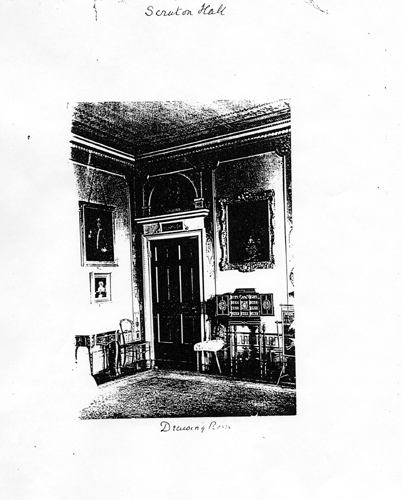 |
 |
||
 |
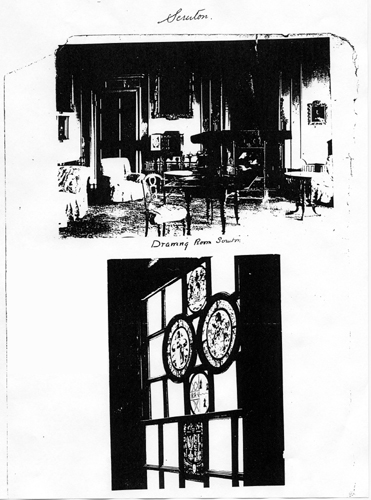 |
||
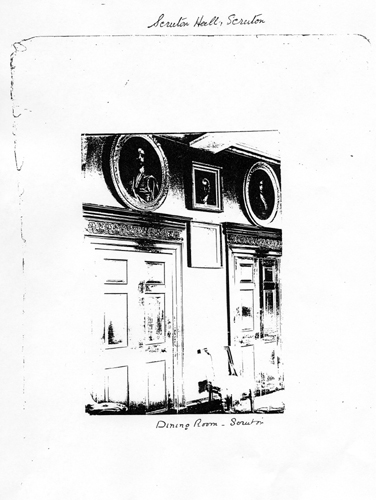 |
 |
||
Contact Us | Site Map